Opinion 15
hpixabay.com/vectors/alice-in-wonderland-small-door-30327/
Brief
Much is written and said about the future of parapsychology and the need for a more unified approach. While it is fine to study discrete forms of apparent Psi phenomena, it is unlikely any real progress will be made without a unifying cosmology. This paper is intended to describe such a model. An example is offered based on what I refer to as the Implicit Cosmology.
Toward a Consciousness Metaphysics
My critique (1) of the Bigelow Institute of Consciousness Studies (BICS) (2) 2021 essay contest included the observation that:
“Some of the essays are useful if the reader wants to read a compilation of reasons to think they will survive physical death. But the emergent message is that academics are only able to show “proof” in the form of personal accounts and by discounting Super-Psi. In my opinion, none of the authors have provided a reasonable metaphysical model (cosmology) that might further our understanding. In effect, a lot of regurgitation and not a lot of contemplation.
In this essay I wish to clarify what I intend by saying there is a need for parapsychologists to develop a consensus cosmology. I will use the Implicit Cosmology (3) as an example. From the Abstract of the essay written to describe the cosmology:
As a field of study, ITC provides an important perspective of consciousness, survival of consciousness and what it means to be a citizen of the greater reality. The relationship amongst the various aspects of reality is described as a cosmology that considers the implications the Trans-survival Hypothesis (4) pose for the dualism versus physicalism debate. The objective of the Implicit Cosmology is to provide a context in which to understand the various concepts associated with the hypothesis such as what is intended by personality, what does perceptual agreement mean, what is mediumship (or the broader concept of transcommunication) and what are etheric fields.
Think of a cosmological model as a likeness of reality based on a particular metaphysical theory. We do not know what the greater reality looks like. However, there are hints that offer a sense of what it might look like. Our task is to compile those hints into a coherent model that others can understand. Next, it is expected that researchers and theoreticians will build on that model by testing assumptions and exploring implications of those assumptions.
While the Implicit Cosmology is designed to explore the implications of Instrumental TransCommunication (ITC), (5) the consensus cosmology I expect the parapsychological community to provide should probably be more general. The idea is to provide guidance for the public based on current understanding. Questions that should be addressed include:
- What are the known inputs and outputs to the model?
- Possible functions within the model that might respond to known inputs to produce known outputs.
- If those functions exist, might they produce other, previously unknown outputs?
- If a nonphysical-physical interface is predicted, how might it work?
- Where do consciousness, mind and brain fit into the model?
- How does the model account for predicted continuation of consciousness beyond bodily death?
- How does the model account for anomalous access to information?
- How does the model distinguish illusion, delusion and apparent Psi sensing?
- How does the model distinguish physical space from nonphysical space?
- Does the model address such perception moderating effects as instinct, discerning intellect and temperament?
- What are the currently successful theories such as First Sight Theory, Hypothesis of Formative Causation, Psi Field that seem to support the model?
- Is there a need to distinguish between a morphogenetic part of mind and that part of mind thought to continue after bodily death.
- What is the relationship between the proposed model and contending theories such as those proposed in Anomalistic and Exceptional Experiences Psychology?
This list is worded in a way that the model would allow for the spectrum of currently popular explanations. All thirteen items address the relationship between a person and the phenomena. Widely known alternative theories should be addressed, if only to show why they are not useful.
As an engineer, I have been trained to bound models to clarify their scope. In a very simple example of such bounding, it is common to bound a calculation with zero at one extreme and infinity at the other. The Implicit Cosmology is bound by curiosity as the initial state and understanding as the final state. Remember that the etheric appears to be based on concepts representing physical things which guide formation of the physical things themselves. The initial expression of curiosity for a universal consciousness might be comparable to the moment of initial expansion of the universal singularity (aka Big Bang) for the physical.
The Implicit Cosmology is a reductionist model in the sense that organizing principles are said to naturally emerge from the expression of curiosity. The organizing principles appear to be comparable to the way David Bohm described his Implicate Order. No divinity is imagined in the model, only the expression of curiosity about the nature of reality and a process by which that curiosity might be satisfied with understanding.
As with the Big Bang singularity, that which produced curiosity is modeled as the initial state which is “outside” of this cosmology.
The model is Bayesian in nature because reported experiences may inherit credibility from previous, similar experiences.
Audience
Cosmologies are function models. For instance, it is best to begin with functions that make Psi possible rather than trying to identify the actual mechanics of Psi expression. It is useful to identify a hypothetical ruleset for the functions describing how incoming signals might be processed to produce expected outputs.
Not knowing the actual nature of phenomena, it is sometimes necessary to keep the model basic. Perception and expressions, for instance, are fundamental characteristics of mostly unconscious mind. Psychic sensing may be a characteristic of perception and psychokinesis may be a characteristic of expression. In the same sense, a movement command to the body would be an expression while becoming aware of one of the bodily senses would be a perception.
The more fundamental the model is, the more versatile it will be. At the same time, the more fundamental models require more self-education by the person using the model. The need for self-education about the function model is no different than the need to be educated about physical principles. Reality is complex and not well-described with a few phrases.
My intended audience are people expressing one or more functions associated with understanding the related phenomena. The functions considered in the development of the Implicit Cosmology are:
Experiencers – People who have experienced apparent paranormal phenomena. This involves typically spontaneous events or visitations but may be the witnessed function of phenomena that is induced by practitioners.
Practitioners – People who induce apparent paranormal phenomena. Most of the phenomena that can be induced, such as psychic functioning, mediumship, healing intention and ITC might also occur spontaneously.
Researchers – People who conduct organized studies of apparent paranormal phenomena. If this is a layperson, the research function is more often referred to as the study function. There is a practitioner-researcher dependency.
Theoreticians – People who develop explanatory models that might guide Experiencers, Practitioners and Researchers. Academically trained researchers are typically better prepared to develop credible models than lay paranormalists; however, laypeople may be better prepared to develop easier to understand models. This function is a feedback generator for the others in that it considers the “so what” implications of information generated by the other three functions.
Characteristics of a Model
“Black Box Analysis” was used during the development of the Implicit Cosmology. It is sometimes used to reverse engineer a device with the intention of replicating its function without violating patents. In effect, the target set of functions are imagined in a hypothetical box for which the engineer only knows the inputs, outputs and expected purpose of the device in the box.
As can be seen in the Black Box Analysis Diagram below, sensed environmental information and inherited influences were the primary inputs for the Implicit Cosmology exercise. Inherited Influences include instincts, cultural teaching and such abstractions as temperament and discerning intellect. See the Implicit Cosmology Diagram below.
For the Implicit Cosmology, the Physical and mental experiences represent conscious self. The cosmology is at the basic functions level, and all outputs of mind are considered expressions. This includes movement commands to the biological body and mental visualization (possible Psi, dreams visions). Conscious perception is derived from expression signals. It is the conscious perception of the output signal that provides the feedback to the mostly unconscious perception forming functions. See the Formation of Expression Diagram below.
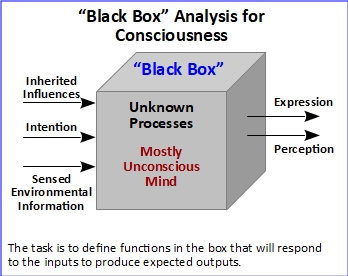
I use the term “mostly unconscious mind” to indicate that such experiences as dreams, visions and trance can modify our lucidity. For instance, a seeker is one who consciously works to develop discerning intellect and increasing discerning intellect tends to improve lucidity. Seeking is the process of aligning Worldview with the actual nature of reality.
Core Functions
Solution to the Black Box Analysis for the Implicit Cosmology turned out to look a lot like the anatomy of our consciousness. The function diagram is shown below in the Attention Complex Diagram below.
Remember that etheric space is modeled here as conceptual in that we think about the concept or idea representing the thing rather than the actual physical or objective thing. With this in mind, the main elements of the black box solution are:
Attention – Think of Attention as a pointer. If the functional areas illustrated in the Attention Complex constitute our mostly unconscious mind, Attention is the attractor that binds those parts as Sentience.
Worldview – The Worldview function is like a database consisting of discerning intellect and biological instincts, cultural training, memory and acquired understanding. Think of it as our personal world map that represents what we think is true. Worldview acts as the arbiter of how we develop expression and perception.
External Influences – The primary environmental influences are from our brain representing our five senses. Think of this as the biological-to-mental interface (aka physical-to-etheric interface). External Influences may also represent Psi influence from other life fields (rapport).
Attention Limiter – A useful way to consider the Attention Limiter is to think of it as our personal data gateway. The Internet gives us a useful analogy. In effect, everyone who is connected to the Internet is connected to everyone else who is connected. Bedlam is avoided by giving everyone a unique address. In a sense, the Attention Limiter contains our unique address. When people think of us, in effect, they call up our unique address. Still, if we do not turn our attention to that signal, we will likely not become consciously aware of it. The strength of that signal is sometimes referred to as rapport. (6)
Intention – While the External Influences function also represents our brain-mind interface, the Attention Channel function represents our conscious self-mind interface. Perhaps the one influence we are able to have on our mostly unconscious expression-perception forming process is our intentionality. As is illustrated by the diagram, our intention does not directly influence our expression or perception. It can only influence how Worldview arbitrates their formation.
Visualization – Information incoming to the Attention Complex is first characterized by the Visualization function based on the content of Worldview. That characterization is tested via the Perceptual Loop to determine how well it agrees with Worldview. This is a very fast, repetitive process that appears to converge perception of the sensed information toward the actual nature of the information. See Lucidity below.
Perceptual Loop – While the Worldview functional area is the database for mind, the Perceptual Loop is the Central Processor function of mind. I refer to the Attention Complex as the Judge because it functions as a preprocessor to either ignore incoming information as unimportant or modify it to better agree with the person’s world map supported by Worldview.
The Perceptual Loop is modeled in the Implicit Cosmology as a “free running” function that is continuously responding to incoming environmental signals. The loop tests incoming information by comparing it to what Worldview predicts. If the information agrees with Worldview, it is sent on to the Expression function.
Here is a possibly confusing point. We consciously experience the output of the Perceptual Loop as it is modified by Worldview. We do not normally experience the raw environmental signal. That means our conscious perception of the world is based on what we think is true and not necessarily the actual nature of our environment. Example reference for this includes:
3 Basic Instincts: Which Dominates You and How It Shapes Who You Are (9)
Expression and Perception – It is the mind that perceives. Conscious self is the Experiencer aspect of mind but experience is always based on Worldview. The objective of people seeking greater lucidity is to teach Worldview so as to align our world map with the actual nature of reality. That is, seekers habitually intend to perceive the actual nature of their world and not as it appears due to cultural training and instinctual urges.
Expression and perception are the same in that we are expressing the result of our Perceptual Loop to other minds, while at the same time, experiencing what we are expressing as our thoughts and as the world we think we live in. This perceiving what we are expressing provides a feedback loop that can lead to understanding if the person is persistent in intending what to understand. Else, human instincts and cultural training dictate behavior and choices. See the Formation of Perception Diagram below.
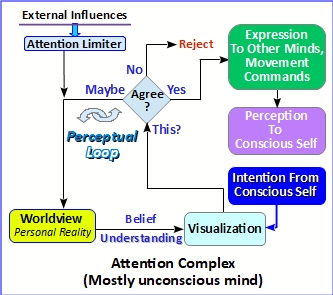
Lucidity
As I developed the Implicit Cosmology, it became evident that the Attention Complex Function Model only represents how we think. (10) (11) Such concepts as purpose, discernment and temperament represent how the Perceptual Loop is biased toward a particular outcome. A useful cosmology must also address the difference between people who live as if they are their body and people who seek to understand their nonphysical nature.
Examining the functions represented in the Attention Complex, it appears that decisions are necessarily based on the contents of Worldview. Contents of Worldview generally come from:
Instincts – Instincts are primarily from species specific Morphogenic memory. The most dominant of these is a sort of human’s prime directive to do anything to assure continuation and dominance of the person’s gene pool. A second, seemingly less influential instinct appears to be the urge related to discerning intellect to gain understanding about the actual nature of the person’s environment. I say “actual” in recognition that the Perceptual Loop returns a version of actual reality based on what the person previously thinks is true. It is useful for the sake of discussion to distinguish between these two forms of instinct as survival or morphogenetic instincts and instinct to seek greater discerning intellect.
Cultural Indoctrination – As we are taught to live in our local community, we are also taught how to correctly think according to our community. Cultural indoctrination and instinctual urge to promote our family combine to entrain our worldview to agree with the dominant social influences.
Memory – Instincts include some automatic responses such as the fight or flight response. The way we integrate experience into memory is also biased by instincts. If our first response to a noise in a dark room is to run, memory of that moment will always be fearful. A common human potential saying is that “It is not what happens to you, but how you react to it that matters.” (Epictetus)
Circumstance – “Opportunity” might be a better term. The circumstances of our life tend to determine the nature of our experiences, and therefore, our memory. For instance, cultural circumstances can decide whether a person has the opportunity to gain an education.
Discernment – As part of a model for the formation of expression and perception, it is useful to describe a continuum with human instincts influencing our decision making at one extreme and discerning intellect at the other. Morphogenic instincts dominate decision making unless they are overridden by mindful intent. See the Temperament Mediated Model Diagram below.
Temperament – As is described below, temperament represents a fundamental driver for choice. It is an important predictor of behavior that appears to be poorly understood by mainstream science. It is treated in the Implicit Cosmology as part of a continuum between entirely instinct-driven behavior and behavior guided by increasing lucidity. Here, “lucidity” is used to describe the degree to which a person perceives reality as it is rather than as it is described by the local culture. (12) (11) (13)
Temperament
An important use of function models is to look for underlying influences that might be required to enable known effects. For instance, a common research question is whether people experience paranormal events because of the presence of Psi phenomena or if they only think they do because of misattribution, delusion or fraud?
The point is that, while perception is largely influenced by Worldview, there appears to be additional moderators that bias the results of the Perceptual Loop.
I have learned to use perspective and point of view to discuss this concept:
Point of View – Used here to describe a person’s sense of their relationship with reality. The more influential points of view for a metaphysical cosmology can be generalized as Physicalism (I am my body), Physical Dualism (consciousness is an emergent quality of biological brain) and Strict Dualism (nonlocal mind). A person’s sense of “I am this” (world map) is based on the person’s point of view.
Perspective – As it is used here, perspective represents a person’s sense of self. A person who assumes that they are their body has a different perspective about experiences than a person who considers themselves an immortal being.
Perceptual Agreement – Perceptual Agreement (14) is an organizing principles defined in the Implicit Cosmology as Personality must be in perceptual agreement with the aspect of reality with which it will associate. The idea is that we are only able to experience that which we understand. That is, we experience a personal version based on our point of view.
A consensus cosmology may not have a principles specifically like Perceptual Agreement, but it should address how a person might have an untenable sense of reality and how that might influence a lifetime.
Hyperlucidity – This term is defined in the Implicit Cosmology as a psychogenic disorder marked by the tendency of a person to find paranormal phenomena everywhere despite considerable testimony to the contrary by peers. (15) (16) (17) This is a form of place syndrome in which visitors might be emotionally overwhelmed for a few days or weeks by the importance of a place. For instance, in Jerusalem Syndrome, an occasional visitors may begin to act out the sense of being an important Biblical figure.
As directors of an organization focused on ITC, we have encountered many instances in which a person becomes convinced that obviously not paranormal experiences can only be explained as paranormal. (18) (19) (20). An important use of a consensus cosmology would be to help experiencers better understand their experiences.
Lucidity – The concept of consciousness has little meaning if talking about the person as an etheric personality. A more appropriate term is lucidity in the sense of a clear and open channel of awareness between the I think I am this (conscious self) and the true I am this intelligent core (personality). The objective of a person seeking greater lucidity is to align the personal world map represented by Worldview with the actual nature of reality. The expression of intention appears to be the seeker’s only way to influence Worldview, so the prescribed approach is for the seeker to habitually examine assumptions.
A person under the influence of hyperlucidity is probably incapable of self-correcting. In fact, we have found that some people are so protective of the paranormality of their apparently paranormal experience that they become hostile when questioned.
Much of the paranormalist’s resistance to cosmological models comes from the failure of current models to reasonably address the implications of mostly unconscious preprocessing sensed information and the influence of Worldview on conscious perception. If expression is the primary influence of the creative process, (21) there is no qualitative difference between apparently normal and apparently paranormal experiences. A consensus cosmology for our etheric nature and our ostensibly paranormal expressions should probably be thought of as a model for the phenomena of consciousness.
Traits
Just as we are born left or right-handed, we are born with basic personality traits that tend to bias the way we integrate new experiences into our worldview. These traits are sometimes referred to as “temperaments.” Learning to understand the mostly unconscious influence of temperaments is generally considered an important step toward learning to manage our normally unconscious thought processes. While the trait’s influence on how we think is mostly unconscious, understanding the basic functions of thought and limits of conscious control can help us manage our choices.
Any standard model for Parapsychology should address the idiosyncrasies of perception. For the Implicit Cosmology, I found it useful to compose the Temperament Mediated Perception for Lucidity Model shown below.
The four trait model I have adapted for this discussion is inspired by the Driver, Analytical, Amiable, Expressive model proposed by David Merrill and Roger Reid (Personal Styles and Effective Performance). (22)
Leader – Seeks to dominate socially and in business. Choices tend to be guided by instinct. Compare with Merrill and Reid’s Driver temperament.
Conformist – Finds protection in numbers. Choices tend to be guided by instinct. Compare with Merrill and Reid’s Expressive temperament.
Wayshower – Understands the need for collective, meaningful progression. Choices tend to be guided by acquired discerning intellect. Compare with Merrill and Reid’s Analytical temperament.
Seeker – Responds to the urge to better understand personal nature and the nature of “meaningful.” Choices tend to be guided by acquired discerning intellect. Compare with Merrill and Reid’s Amiable temperament.
People can be described as a primary and secondary trait such as Leader-Seeker.
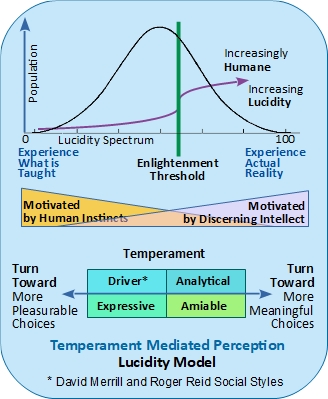
First Sight Theory
An important hint about what guides the choices being made within the Perceptual loop comes from First Sight Theory (7) proposed by psychologist James Carpenter. (23) The theory represents the kind of compilation of research into a theoretical model that can guide other researchers and lay practitioners.
First Sight Theory consists of the complementary propositions that our conscious perception emerges from psychically sensed environmental information (Psi) that is preprocessed in our mostly unconscious mind, and that all of our expressions are accompanied by a psychokinetic influence. Of the thirteen corollaries, the following are probably the most important for the Implicit Cosmology. Be aware that I may have paraphrased the corollaries:
Integration: Preconscious processes are processed together with Psi in a rapid, holistic, efficient, unconscious manner to format experience and action. Corollary 3
Weighting and Signing: The importance of sensory and extrasensory information is weighted as being more or less important before it is acted upon. Corollary 5
Summation: The content of conscious experience, emotional states and behavioral choices are constituted in a summative way by unconscious thought. Corollary 6
Bidirectionality: In this summative process, the person may turn toward information (signed positively) to include it in the construction of experience, affect or action, or turn away from information (signed negatively) and exclude it. Corollary 7
Switching: A person will be fairly consistent in how information is processed, (but) may switch in how information is weighted, the sign attributed to it, and therefore, whether or not it is included in behavior. This switching will occur rapidly or slowly depending on the consistency and purity (focus) of unconscious intention, and this, in turn, is determined by the relative weight of the information over time, situational factors that promote or diminish critical analysis, changes of approach in a task and mood. Corollary 9
Extremity: The frequency of switching affects the relative density of accumulated additive or subtractive references to the meaning in question. Rapid switching renders potential meaning irrelevant to ongoing experience. Corollary 10
Nature’s Habit
A second theory I often turn to for support of the Implicit Cosmology is Rupert Sheldrake’s Hypothesis of Formative Causation. (24)
The process of an organism’s cell dividing into a particular kind of cell (skin, bone, blood) is known as morphogenesis. The mechanism controlling morphogenesis remains unclear despite the many theories designed to explain the process. Biologist Rupert Sheldrake’s proposal that a nonphysical memory field controls the process helps solve the black box puzzle. He refers to the field as a morphic field (morphogenetic field).
Sheldrake provides a good overview of his theory in Morphic Resonance and Morphic Fields – an Introduction. (25) I have paraphrased a summary:
- Morphic fields are self-organizing wholes as bound by Organizing Principles, especially the Principle of Perceptual Agreement in the Implicit Cosmology.
- Morphic fields are not bound by space or time. Put another way, they are unique to and support specific species as the population evolves over time and anywhere the organism exists in the world.
- Sheldrake explains that morphic fields control morphogenesis via a process he describes as morphic resonance guided by Nature’s Habit. That is, organisms form in the same way they have always been formed. They do so by what I refer to as the expression of intended order expressed by the species’ collective morphogenic mind. This appears to be essentially the same process involved in the etheric-to-physical formation of transform ITC phenomena.
- Morphic fields are hierarchical in a similar way as fractals. Looking back at the Mandelbrot Set, above, they are specific to a part of the organism while being a part of the whole organism. Sheldrake refers to the nested morphic field controlling individual cells or group of cells as holons. Each holon represents a local attractor for the part of the organism under its influence.
Think of a holon as a discrete “mind” controlling a local collective of entities (skin cells for instance) but which is also part of the collective of holons composing the top fractal of what I refer to as the morphogenetic mind for that species. Think in terms of a cell life field in the etheric expressing the biological cell in the physical. Again, mind acting on conceptual space to express an objective presence.
- Nature’s habit does not mean every change in behavior of the organism is included in the memory. It means that successful changes that further the survival of the organism are more likely to be included. It appears Worldview in the Attention Complex discussed below is modified in much the same way. The current state of Worldview and Nature’s Habit has considerable momentum. Sheldrake has referred to this point in terms of Nature’s Habit being evolved in small increments by the influence of successful, creative solutions to environmental challenges.
Two Mind Model
I have found it useful to model a person as an immortal self entangled with a human in an avatar relationship. As shown in the Implicit Cosmology Diagram below, the Intelligent Core Represents the attractor that binds the functional areas of the symbiotic life field. It is modeled as Mind 1.
The Morphogenic Mind represents the host or avatar as a biological organism (Mind 2). An assumption of the cosmology is that the biological organism has an independent existence, but that its expression-perception functions are shared with the symbiotic Mind 1 during entanglement.
By thinking of a person as a symbiotic life field sharing the formation of expression and perception with a second life field functioning as an avatar, it becomes easier to realize the extent of influence human instincts have on behavior.
Based on observation, the avatar’s influence of Attention Complex sharing is dominant unless overridden by the mindful expression of discerning intellect. If true, that would seem to indicate that people are first instinctual and then mindful.
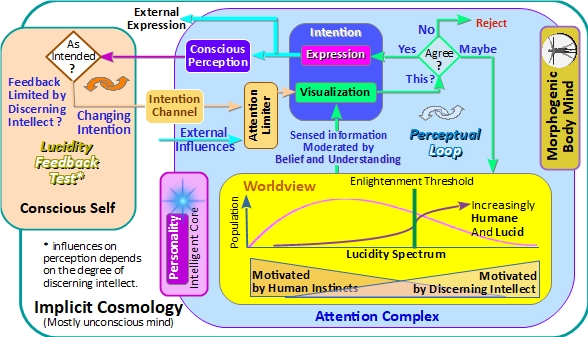
The Implicit Cosmology is illustrated here. While I am using that cosmology as an example, the diagram illustrates functions that seem necessary for a useful model. Note that:
- The model represents nonphysical functions of mind.
- Perception, which is that which a person becomes consciously aware, is derived from expression. In turn, expression is formed in an iterative process described here as the Perceptual Loop.
- The Perceptual Loop is moderated by Worldview which represents cultural influences, human instincts, discerning intellect and memory. This information (influence) is biased by the influence of temperament, learning styles and possible prior understanding. Understanding is characterized here as discerning intellect producing greater lucidity.
- Intention appears to be the only influence exerted by aware self on the Perceptual Loop. That would be a “small force” influence on the content of Worldview.
- The Lucidity Feedback Test represents the question “Is this what I intended?” The model assumes that what is consciously intended is compared to perception of what was expressed. See the Formation of Perception Diagram below.
- All functions operate in real time and are free running. Time scale appears to be microseconds.
If nonlocal, long-lived consciousness is considered:
- External expression may be a psychokinetic etheric-physical influence such as movement commands for the body or an etheric-etheric influence such as a thought intended for another life field.
- Environmental signals might be from the body senses but might also be from other life fields.
If the Survival Hypothesis is considered:
- In this cosmology, the life field is considered the building block thoughtform. As such, reality consists of a nested hierarchy of life fields and their expressions. The physical is modeled as an expression.
- Life fields are modeled as a core intelligence (The Observer), An Attention Complex (The Judge) and an Aware Self (The Experiencer). During embodiment, entanglement between the avatar and the symbiont is thought to be a sharing of conscious self (perception) and Attention Complex. If so, the momentum of Worldview would seem to necessitate (a period of readjustment after biological death. Seekers learn that greater lucidity means clearer perception, especially when human instincts are absent.

Purpose
Our human instincts are motivators that turn us toward behavior intended to assure the dominance of our gene pool. In a similar way, it is thought that people have an instinctual urge to be curious about themselves and reality. This urge is sometimes referred to as a spiritual or seeking spirituality. I model it as discerning intellect.
As is shown in the Worldview functional area of the Implicit Cosmology Diagram above, I identify the Lucidity Spectrum as the continuum between choices entirely guided by human instinct and choices more guided by discerning intellect. The turning point is sometimes referred to as enlightenment.
A useful unifying cosmology would consider the possibility of such mind related instincts and how they might relate to biological instincts. Can the cosmology support such a possibility? If human instincts have evolved with the human, from what might be the source and purpose of an instinctual urge to be curious about ourselves?
Navigating the Etheric
We navigate “within” our mind by changing focus. That is why the expression and perception forming part of mind is modeled here as the “Attention Complex.” Rapport (6) is a good example of this concept. There is also the notion of “Switching” described in First Sight Theory. (7)
Parapsychologists have named psychic influence as Psi and the characteristic of reality that propagates Psi as the Psi Field. It has made sense to think of reality in terms of fields. The three most fundamental fields in the Implicit Cosmology are the reality field, the life field and the thoughtform.
I used curiosity as a characteristic of First Cause. The urge to satisfy that curiosity is the expression which produces the formative influence seen as the expression of life fields. As such, all life fields are conceptually “in” the reality field. Following the nested hierarchy architecture, life fields inherit curiosity from their “thinker.” That inherited curiosity is, in turn, a source of purpose for the thoughtforms they express.
As previously noted, life fields are treated as building blocks of reality. They are the only causative aspect of reality and consist of a core intelligence which represents purpose and acquired understanding (Observer), an expression-perception forming functional area (Judge) and a conscious self which supports intentionality (Experiencer).
Reality is typically portrayed as a layer cake with the coarser levels (mineral, plant, animal) at the bottom and finer levels (etheric, spirit) at the top. Some systems of thought referred to these levels as dimensions or planes of existence.
I have found it makes more sense to think of reality in terms of fractals and chaos theory. As such, life fields are treated as fractals arranged in a nested hierarchy in which perceptual characteristics are the attractors. The example I use is the Mandelbrot Set, although the comparison should be taken as “like” and not “literally.”
The Mandelbrot set consists of the numbers from -2 to +1 on the Real or Rational Number Line and -1 to +1 on the Irrational or Imaginary Number Line. In math, a complex number is one that includes an ordinary number and an imaginary number such as: X + Yi. “Yi” is the imaginary number where “i” is written as i = (the square root of minus one), which is a disallowed state in ordinary math since a number times itself is always a positive number.
It is not my intention to equate the imaginary status of a coordinate marked by a Yi with the Psi Field, but the way one “navigates” the Mandelbrot Set does seem to give us a sense of the difference between navigating the cartesian space of the physical and the imaginary space of mind.
The equation for the Mandelbrot Set is:
Z n+1 = Zn2 + C
where Z0 = C
Values of C that are in the Mandelbrot Set are those for which the value of Zn does not go to infinity. That is, the formula is calculated with an initial value of C, and then calculated many times with the previous result used for the next value of C. The equation is calculated in this way a predetermined number of times or until the result either goes to infinity or settles in a narrow range of numbers. The final value is typically assigned a color value as it is placed in a plot of all of the numbers in the set.
The top “Apple Man” fractal forms in the plot as each point (x, yi) is calculated. It is a large area of points that are relatively stable.
Navigation is by “telescoping” into Mandelbrot Space by selecting a smaller number (x, yi) to begin the calculation. For instance, the Navigation Within the Mandelbrot Set Plot below, shows a plot for Real Number: -1.165, Imaginary Number: -0.288). Where one focuses in the set depends on the initial value for C.
Mandelbrot space is infinitely small and there is an infinite number of the apple man fractal scattered in an extremely complex environment. As a thought exercise, compare the target “C” as the perspective of reality with which we wish to associate. Our worldview represents the allowable limits of “C.” The principle I refer to as the Formative Principle of Perceptual Agreement applies here: Personality must be in perceptual agreement with the aspect of reality with which it will associate. A Life Field cannot associate with (perceive, experience, influence) unless its worldview allows for the existence of that aspect of reality.
Compared with the “C” in the Mandelbrot equation, our perceptual agreement determines that part of reality we are able to experience. Recognizing this in the cosmology can help the individual understand that, if true, the implication of the etheric as conceptual space is that increasing lucidity may enable greater access to reality. Continuing the Mandelbrot comparison, greater lucidity is like allowing “C” greater access to the set plot.
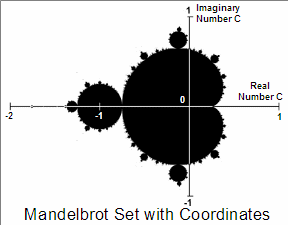
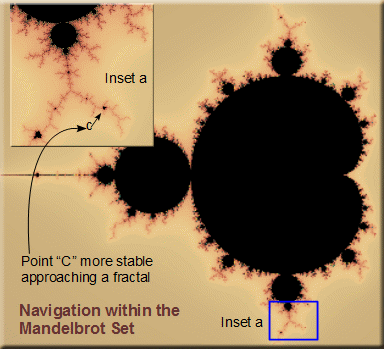
Closing Comments
Ostensibly paranormal experiences are symptomatic of dynamics and environments that do not appear to be addressed by physical sciences. To say that nonphysical aspects of reality seem to be involved in thought and Psi-related phenomena is to step outside of known science. To be correct, I should say “outside of accepted science.” In one way or another, most parapsychologists are keenly aware that there are nonphysical aspects of paranormal experiences. It is just that the study is very far out on the frontier of science.
The impression one gets in reviewing parapsychological literature is that it is all about ghost hunting, mediumship and the big three of reincarnation, near-death experiences and out of body experiences. There is hardly any reference to ITC in the literature and not much about healing intention. Grief management is a mostly neglected aspect of the paranormalist community.
There is a lot of talk about improving parapsychology but little effort to consolidate the community. As witness the 2022 Bigelow Institute of Consciousness Studies (BICS) (2) essay contest, most supposed science conducted in parapsychology has been historical accounts, compilation of disparate experiences and philosophical handwaving. Studies of such reported experiences as reincarnation, near-death experiences and out of body experiences seem to be typically conducted in isolation from such lesser-known experiences as ITC and mediumship.
I have participated in the New Age culture since the fifties. Since 2000, I have been immersed in the study of ITC. To this day, I have seen hardly any science-based forward progress in what is widely accepted as basic understanding about the nature of things paranormal. Lacking a fundamental change in approach, I see no reason to expect forward progress.
As a paranormalist community, we know a lot more than we seem to realize. The problem seems to be that we cannot find a consensus for what that understanding looks like. That is why I am recommending a consensus cosmology.
Think of a consensus cosmology as a theoretical sandbox in which we can explore the sensibility of concepts and relationships. It need not be absolutely correct. We should expect it to evolve … a lot at first. Over time, it should become more stable as it is refined.
Lacking such a cosmology, we are left to invent gods and devils.
References
- Butler, Tom. “Review of Runner Up BICS Essays.” Etheric Studies. 2022. ethericstudies.org/2021-bics-essay-reviews/.
- Bigelow Institute for Consciousness Studies (BICS). bigelowinstitute.org/.
- Butler, Tom. “Implicit Cosmology.” Etheric Studies. 2015. ethericstudies.org/implicit-cosmology/.
- Butler, Tom. “Trans-Survival Hypothesis.” Etheric Studies. 2015. ethericstudies.org/trans-survival-hypothesis/.
- Butler, Tom. “ATransC White Paper on Transcommunication.” Association TransCommunication. 2014. atransc.org/itc-white-paper/.
- Mügge, Kai. “Society for Research in Rapport and Telekinesis (SORRAT).” Felix Experimental Group. 2008. kaimuegge.com/sorrat/.
- Butler, Tom. “About First Sight Theory.” Etheric Studies. 2018. ethericstudies.org/first-sight-theory/.
- Bargh, John A. and Morsella, Ezequiel. “The Unconscious Mind.” US National Library of Medicine, National Institutes of Health. 2008. ncbi.nlm.nih.gov/pmc/articles/PMC2440575/.
- Forsythe, Francesca. “3 Basic Instincts: Which Dominates You and How It Shapes Who You Are.” Learning Mind. 2017. learning-mind.com/basic-instincts-dominant/.
- Butler, Tom. “How We Think.” Etheric Studies. 2014. ethericstudies.org/how-we-think/.
- Butler, Tom. “Mind as Storyteller.” Etheric Studies. 2019. ethericstudies.org/mind-as-storyteller/.
- Buckley, Dylan. “4 Most Common Temperament Types.” Better Help. 2020. betterhelp.com/advice/temperament/4-most-common-temperament-types/.
- Poncela-Casasnovas, Julia et al. “A study on human behavior has identified four basic personality types.” uc3m – Universidad Carlos III de Madrid. 2016. uc3m.es/ss/Satellite/UC3MInstitucional/en/Detalle/Comunicacion_C/1371223155576/1371216052182/A_study_on_human_behavior_has_identified_four_basic_personality_types.
- Butler, Tom. “Perceptual Agreement.” Etheric Studies. 2015. ethericstudies.org/perceptual-agreement/.
- Durst, Dr Rimona. “Jerusalem syndrome.” The British Journal of Psychiatry, 176: 86-90. 2000. bjp.rcpsych.org/content/176/1/86.full.
- Nashawaty, Chris. “The Jerusalem Syndrome: Why Some Religious Tourists Believe They Are the Messiah.” Wired Magazine. 2012. wired.com/2012/02/ff-jerusalemsyndrome/.
- Butler, Tom. “Becoming Lucid.” Etheric Studies. 2020. ethericstudies.org/becoming-lucid/.
- Butler, Tom. “EVP Online Phantom Voices.” Association TransCommunication. 2012. https://atransc.org/phantom-voices/.
- Leary, Mark. “A Research Study into the Interpretation of EVP – Three parts.” Association TransCommunication. 2013. atransc.org/radiosweep-study2/.
- Butler, Tom. “Radio-Sweep: A Case Study.” Association TransCommunication. 2009. atransc.org/radiosweep-study1/.
- Butler, Tom. “The Creative Process.” Etheric Studies. 2014. ethericstudies.org/creative-process/.
- Merrill, David W. and Reid, Roger H. “David Merrill & Roger Reid: Social Styles.” Management Pocketbooks. 2017. pocketbook.co.uk/blog/2017/04/18/david-merrill-roger-reid-social-styles/.
- Duggan, Michael. “James Carpenter.” Psi Encyclopedia. 2020. psi-encyclopedia.spr.ac.uk/articles/james-carpenter.
- Butler, Tom. “Morphic Fields.” Etheric Studies. 2018. ethericstudies.org/morphic-fields/.
- Sheldrake, Rupert PhD. “Morphic Resonance and Morphic Fields.” Rupert Sheldrake. sheldrake.org/research/morphic-resonance/introduction?
![]()

